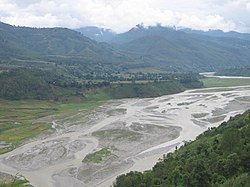| Indravati River/Indrawati River/ Melamchi Khola | |
|---|---|
 Indravati River Indravati River | |
| Location | |
| Country | Nepal |
| Physical characteristics | |
| Source | |
| • location | Himalayas |
| Mouth | |
| • location | Sun Kosi at Dolalghat |
| • coordinates | 27°38′46″N 85°42′14″E / 27.646°N 85.704°E / 27.646; 85.704 |
| Basin features | |
| River system | Koshi River |
The Indravati River (Nepali: इन्द्रावती नदी) in Nepal is a tributary of the Sun Koshi River. It used to be called "Melamchi" or "Melamchu" until the 19th century.
Course
The source of the Indravati River is located in the south-facing slopes of the Himalayas. Its upper course is characterized by a steep gradient, precipitous slopes, huge boulders and rocks in the river valley, and large rapids. It flows through alpine, sub-alpine and temperate forests. Settlements occur along its lower course. The Indravati's catchment area includes the eastern slopes of the Kathmandu basin and extends to the Indravati – Sun Koshi water divide.
The Indravati meets the Sun Koshi at Dolalghat, located on the Arniko Highway that links Kathmandu with the Nepal-Tibet border.
Koshi River system
The Koshi River drains eastern Nepal. It is also known as the Saptkoshi because of the seven rivers joining in east-central Nepal to form this river. The main rivers forming the Koshi River system are the Sun Koshi, Indravati, Tamma Koshi, Bhote Koshi, Dudh Kosi, Arun and Tamur Rivers. The Saptkoshi River flows through the Chatra Gorge in a southerly direction into northern Bihar in India and joins the Ganges.
Quake
The April 2015 Nepal earthquake rupture began 80 km (50 mi) to the northwest of Kathmandu and propagated eastward for about 130 km (81 mi), rupturing the area directly located under the capital city of Nepal. The rupture ends in the zone of the western fringes of the Indravati river.
References
- ^ Sharma, U. P. (1996). Ecology of the Koshi river in Nepal-India (north Bihar): a typical river ecosystem. In: Jha, P. K., Ghimire, G. P. S., Karmacharya, S. B., Baral, S. R., Lacoul, P. (eds.) Environment and biodiversity in the context of South Asia. Proceedings of the Regional Conference on Environment and Biodiversity, March 7–9, 1994, Kathmandu. Ecological Society, Kathmandu. Pp 92–99.
- Malla, K. P. (1983). River-names of the Nepal valley: A study in cultural annexation. Contributions to Nepalese Studies 10 (2): 57–68.
- Negi, S. S. (1991). "Indravati River". Himalayan Rivers, Lakes, and Glaciers. New Delhi: Indus Publishing Company. p. 75. ISBN 9788185182612.
- Dorje, G. (1999). Tibet Handbook: with Bhutan. Bath: Footprint Handbooks. ISBN 9781900949330.
- Negi, S. S. (1991). "Kosi River System". Himalayan Rivers, Lakes, and Glaciers. New Delhi: Indus Publishing Company. pp. 89–90. ISBN 9788185182612.
- Vervaeck, A.; Daniell, J. (2015). "Deadly Nepal Gorkha/Kodari earthquakes - 8,902 people dead + 250 missing & list of names". SOS Earthquakes. Archived from the original on 2018-12-24. Retrieved 2015-05-09.
| Hydrography of Nepal | ||||||||||||
|---|---|---|---|---|---|---|---|---|---|---|---|---|
| Rivers |
| |||||||||||
| Lakes | ||||||||||||
| Glaciers | ||||||||||||
| Icefalls | ||||||||||||
| Dams, barrages | ||||||||||||
| Related topics | ||||||||||||
| Kosi basin | |||||||
|---|---|---|---|---|---|---|---|
| Rivers | |||||||
| Dams, barrages, bridges | |||||||
| Geographical features | |||||||
| Important localities | |||||||
| Floods | |||||||
| Riparian districts/ areas |
| ||||||
| Languages/ people | |||||||
| Transport | |||||||
| Other basins | |||||||